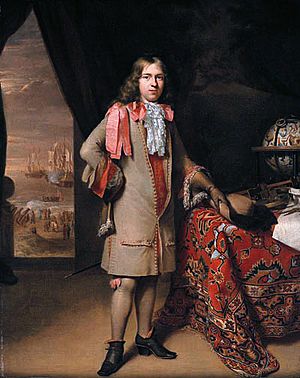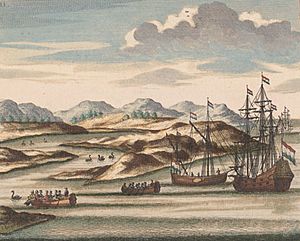Willem de Vlamingh facts for kids
Quick facts for kids
Willem de Vlamingh
|
|
|---|---|

Portrait thought to be of De Vlamingh
|
|
| Born |
Willem Hesselsz de Vlamingh
Oost-Vlieland, Dutch Republic
|
| Baptised | 28 November 1640 |
| Died | Unknown date, c. 1698 (aged 57–58) |
Willem Hesselsz de Vlamingh (born November 1640 – died around 1698) was a Dutch sea captain. He explored the central west coast of New Holland (which is now Australia) in the late 1600s. He landed in the area that is now Perth on the Swan River. His mission to find a lost ship was not successful, but he mapped parts of Australia's western coast.
Contents
Willem de Vlamingh's Early Life
Willem de Vlamingh was born in Oost-Vlieland, a place in the Dutch Republic (which is now the Netherlands). He was born in November 1640. In 1664, De Vlamingh sailed to Novaya Zemlya and found a new area he called Jelmerland. He got married in 1668. At that time, he worked as a skipper, a captain of a ship, for whaling. He still lived on the island of Vlieland.
In 1688, De Vlamingh joined the Dutch East India Company (VOC). This was a powerful trading company. He made his first trip to Batavia (now Jakarta, Indonesia) that same year. After a second trip in 1694, he was asked to lead an important journey. This was requested by Nicolaes Witsen, a director of the VOC. The goal was to find the ship Ridderschap van Holland. This large VOC ship was lost in 1694 with 325 people on board. VOC officials thought it might have crashed on the western coast of Australia.
The Rescue Mission to Australia
In 1696, Willem de Vlamingh led a rescue mission. He sailed to Australia's west coast to look for people who might have survived the Ridderschap van Holland. Three ships were under his command. These were the Geelvink, which De Vlamingh captained himself. The other ships were the Nijptang, led by Captain Gerrit Collaert, and the Weseltje. The Weseltje was a smaller ship called a galiot, captained by Cornelis de Vlamingh, Willem's son.
The expedition left Texel on May 3, 1696. They sailed secretly because of a war with France. They went around the coast of Scotland to Tristan da Cunha. In early September, the three ships reached the Cape of Good Hope in Africa. They stayed there for seven weeks because many crew members were sick with scurvy. Scurvy is a serious illness caused by not getting enough vitamin C. While there, Cornelis de Vlamingh took command of the Weseltje after its first captain died. On October 27, they left the Cape. They used the Brouwer Route, a faster way to sail across the Indian Ocean to the Dutch East Indies. On their way east, they checked Île Saint-Paul and Île Amsterdam, two islands. But they found no wreckage or survivors. On December 5, they continued their journey.
Discovering Rottnest Island
On December 29, 1696, De Vlamingh's group landed on Rottnest Island. This island is off the coast of Western Australia. He saw many quokkas there. Quokkas are small marsupials native to the area. De Vlamingh thought they were large rats. So, he named the island 't Eylandt 't Rottenest, which means "Rats' Nest Island".
He wrote about the island in his journal. He said he enjoyed seeing the island very much. He thought it was beautiful and had everything needed for people to live well. He mentioned timber, stone, and lime for building houses. He also noted plenty of salt and many fish along the coast. Birds sang sweetly in the fragrant trees. He believed that many people would prefer this island, which seemed like a "paradise on earth," over their own countries.
Exploring the Swan River
On January 10, 1697, De Vlamingh sailed up the Swan River. He and his crew are thought to be the first Europeans to do this. They are also believed to be the first Europeans to see black swans. De Vlamingh named the river Zwaanenrivier (Swan River in Dutch) because of the large number of black swans they saw there.
The crew split into three groups. They hoped to catch an Aborigine, a native person of Australia. However, about five days later, they stopped trying to find a "South lander."
Continuing the Journey
On January 22, they sailed through the Geelvink Channel. In the next few days, they saw ten black people. On January 24, they passed a place called Red Bluff. Near Wittecarra, they searched for fresh water. On February 4, 1697, De Vlamingh landed at Dirk Hartog Island in Western Australia. He found a pewter plate that Dirk Hartog had left there in 1616. De Vlamingh replaced it with a new plate. This new plate recorded the visits of both Dutch sea captains. The original plate is now kept in the Rijksmuseum in Amsterdam.
De Vlamingh, along with his son and Captain Collaert, commanded a group of ships returning from the Indies. They left on February 3 or 11, 1698. The ships arrived back in Amsterdam on August 16. However, it is not certain if De Vlamingh was still alive at that time. There are no burial records for him in Vlieland from around this period.
Earlier, De Vlamingh had sent a box to Nicolaes Witsen. The box contained seashells, fruits, and plants from New Holland (Australia). It also had eleven drawings made by Victor Victorsz during the expedition. De Vlamingh also included some black swans, but they died during the long journey. Witsen offered the drawings to Martin Lister, a famous scientist. Witsen, who had helped pay for the journey, was disappointed. He felt the men were more interested in setting up trade than in exploring. In 1699, another explorer named William Dampier would explore the coast of Australia and New Guinea.
See also
 In Spanish: Willem de Vlamingh para niños
In Spanish: Willem de Vlamingh para niños


